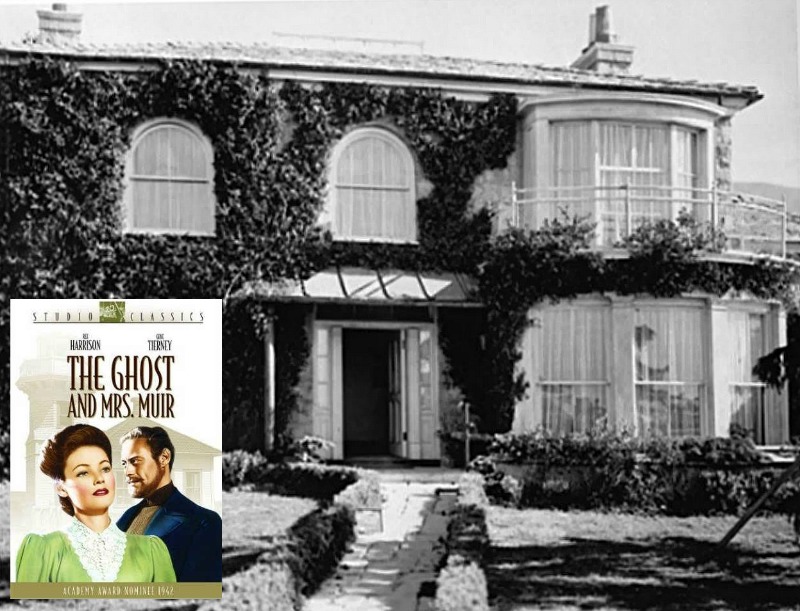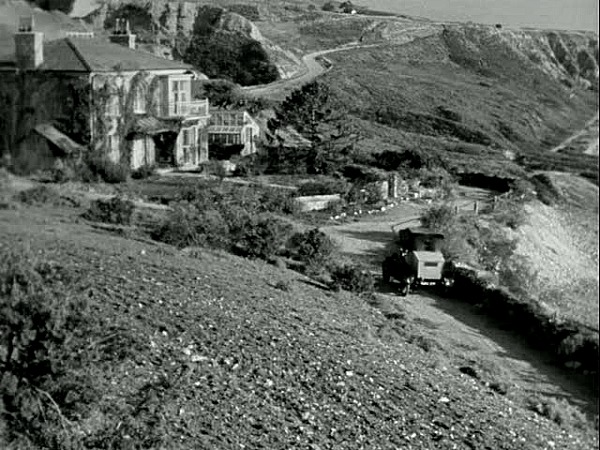A great comfort to me during lockdown was the British program on YouTube, Time Team. Time Team is an archaeology program, broadcast on Channel 4 from 1993 to 2013. Numbers of episodes for each year varied, but there were generally 9-12 episodes a season, and they are all on YouTube. And, I guess the reason that all of the episodes are on YouTube is that there are a number of people who were so passionate about Time Team and archaeology, that they copied all of the episodes off live TV back when VCR technology was new.
In a sense, it's a reality show. Archaeologists swoop down on a site, and they have just three days to do enough research to answer a question. I suppose that unlike most reality shows, it really is "real," not non-scripted make-believe, although the extensive set-up and take-down all occurs off-camera, before and after the famous three days.
For instance, in the case of the manor house Hooke Court, in Dorset, now a school, the question was, "What did Hooke Court look like before it was burned during the English Civil War?" and accompanying questions, like who owned it and how was it used? And given that there's a small moat, extending around about 30% of the school site, another question is, did the moat once go all the way around the school site?
Like other reality shows, Time Team raises suspense for its viewers by creating a false (in this case, real) crisis: can they find the answer in three days? And, mostly, they do, but not without some bumps along the way.
The central idea of Time Team is that the advent of geophysical radar mapping of a few feet immediately below the ground permits a team of archaeologists to descend on a site, use the ground radar maps to choose sites to dig, and uncover meaningful information in just three days.
Presenter Tony Robinson sometimes seem like he's on the verge of hysteria: the threat that the posed question might not get answered, or, the lost item the team has come to uncover might not be found, has him raising his voice, gesticulating, and in great danger of failing to be entirely polite. He asks the questions, often about terminology, that the audience would ask if they could.
The "mission" at Hooke Court was to discover if all of the manor house
complex had burned during the English Civil War or if some remains,
either above or below ground, are older, and to find out if the moat
once encircled the manor house. By the end of the dig, the
archaeologists and the architectural historian disagreed on the location
of the great hall, and there just wasn't any more time to dig. Further,
Hooke Court's appearance in the Domesday Book shows that there was
some kind of Anglo-Saxon settlement at Hooke Court, and the Anglo-Saxon
who owned it survived the Norman Conquest and was named a thane of
William the Conqueror.
In the case of Hooke Court, the architectural historian found that a
building a Hooke Court that was pulled down (or fell down) in the recent
past, was the former gatehouse of the manor. The archaeologists used
the ground-penetrating radar, or "geophys," as it's called on the show,
to see that that there were extensive traces of buildings under the
ground. It seems likely that there were successive buildings on the site
given that its history goes back to the Norman Conquest and likely
earlier.
John Gater, the man in charge of the geophysical
mapping, shows the archaeologists some readouts of his crew's mapping
work, and the outlines of a large building are seen. The archaeologists
start digging, to prove this thesis, and . . confusing evidence
emerges. Several large trenches are dug, and several walls are
uncovered, but the archaeologists don't have enough time to find all the
"returns," that is, to find all of the corners that belong to these
walls that would allow the archaeologists to see the outline of the
Great Hall and possibly other buildings.
And Hooke Court is a little bit of a failure. In three days, an architectural historian shows that the last remaining building of Hooke Court, which used to be manor house with multiple buildings like a gatehouse, a great hall, outbuildings like a kitchen, a stables, a dairy, a brewery, was originally a 15th century tower house, to which additions were made in the 16th, 17th, and 19th centuries. While Hooke Court is not unusual in this respect, it's a fine illustrative example of how manor homes evolved over the centuries.
What is true of this episode, as of many episodes, is that Stewart Ainsworth, a landscape archaeologist, swoops in and decides some question late in the program by offering an analysis of the landscape--the height of the site and its surrounding area, nearby rivers or streams, and the presence of natural defenses. All of the Time Team experts have many fans, but I think that Stewart Ainsworth's work had the greatest impact on changing my understanding of archaeological sites. Also, there's this interesting tension between the expertise of Ainsworth and the archaeologists. Perhaps Hooke Court is not the most interesting Time Team episode, but it's a fine example of how Ainsworth would present a view based on his expertise that would change your view of the site, or the problem, or explain why what was found by the archaeologists (or not found) differed from what was anticipated, late in the episode.
And, a typical Time Team episode features a host of visiting experts: archivists and historians, pottery experts, Anglo-Saxon experts, nautical and aviation experts, Roman experts, Phillippa Gregory on the history of the War of the Roses when Time Team visited Groby, the ancestral home of Elizabeth Woodville's in-laws, and the list goes on.
The architectural historian argued for one position, one of the archaeologists argues for another, and super-digger and enthusiastic flint expert Phil Harding opines that there's a large building, it appears, heading off in another direction, so that the episode ends with uncertainty. On camera, Tony Robinson asks Phil Harding is there's anything that can be done to settle the question: possibly some test pits (small trenches one meter by one meter in dimension or perhaps a little larger), and Phil shakes his head. There is, finally, a limit to how much can be done in three days, even on Time Team.
Research of soil samples shows that the moat did not go all the way around the school site, and Ainsworth steps in and explains: the site, which held a manor house (or the Anglo-Saxon version of that, just a timber building) going back to before the Conquest, sits on a ridge and was chosen for being a high place, making it harder to attack and easier to defend. Ainsworth shows an early nineteenth-century tithe map which shows that in the past, the moat was actually smaller than it is now, and he conjectures that it was expanded to heighten its decorative effect, and that the moat/ditch was originally built when defense was a real issue, to prevent attack from that direction.
My favorite episodes on Time Team are the medieval episodes, where written history is often an important component of the archaeological investigation. I think my three favorite episodes are the very first episode, an exploration of Aethelney, in Somerset, the site of Alfred the Great's guerilla camp, where no digging but other investigative techniques are used; Much Wenlock, where the development of a medieval town outside the gates of an abbey is investigated (Norman economic development); and Hooke Court, a somewhat (but not perfectly!) typical manor house.
Archaeologist Mick Aston was, in a manner of speaking, the star of Time Team, an archaeology professor from the University of Bristol with a committed passion for bringing archaeology to ordinary people, the genesis for Time Team. I have to say I admire Aston's vision, because it seems that there are many fans who are very passionate about Time Team. And, in fact, part of what I love about Time Team myself is that the archaeological excavations often reveal facts about the lives of ordinary people which is what I find most interesting. I think this is what Carenza Lewis studies; I found her analysis of the abandonment of villages after the Black Death so interesting. I've always felt confused about what the social impact of the Black Death on English farmers was and, as you can imagine, watching Time Team has helped me to understand it much better.
Time Team producer Tim Taylor recently spoke to Tony Robinson on YouTube about Time Team's history, and Robinson mentioned that Channel 4 preferred episodes to feature ordinary people and to portray the digging up of their back gardens. In fact, that's my own preference: my favorite episodes all have ordinary people with questions about archaeology and I find that very charming. In the Much Wenlock episode, the "ordinary person" answers the door to Mick and Tony on Easter day and apologizes that the meal is not quite ready yet. The lesson that Mick wanted to impart, about how traders came to the gates of abbeys to provide goods and services to the monks, and then came again for fairs, and then built a house on the back of their stall, and so a small market town was created, was exactly the kind of thing I wanted to know more about--because I'd read Henri Pirenne's Medieval Cities, where Pirenne talks in the abstract about what Mick Aston is here talking about in the particular. And there it is, right on Time Team. 
Today, Time Team producer Tim Taylor is leading an effort to create new Time Team episodes, funded by Patreon. I believe he is planning two digs next year and that one of them will be in Cornwall. Here's a recent video in which he offers up an update: https://www.youtube.com/watch?v=Y4_QOBnLEro


 I found the Ghost and Mrs. Muir to be so charming. I'd seen it once or twice before years ago, and I wondered if I really wanted to see it again. I'm so glad I did. I'd forgotten how, for all its fantasy (it is, after all, the story of a widow who falls in love with a ghost), it seems to hold a kernel of psychological reality.
I found the Ghost and Mrs. Muir to be so charming. I'd seen it once or twice before years ago, and I wondered if I really wanted to see it again. I'm so glad I did. I'd forgotten how, for all its fantasy (it is, after all, the story of a widow who falls in love with a ghost), it seems to hold a kernel of psychological reality. 



